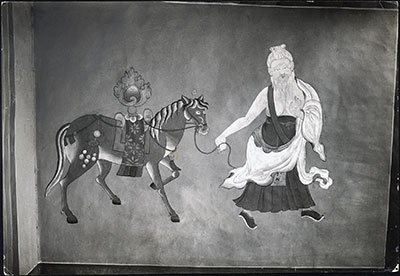
1998.131.339.2 (Print black & white)


1998.131.339.2 (Print black & white)

Frederick Spencer Chapman
Frederick Spencer Chapman
February 16th 1937
Lhasa > Norbu Lingka > Stables
1998.131.339.2
130 x 190
Print gelatin silver
Donated 1994
Faith Spencer Chapman
British Diplomatic Mission to Lhasa 1936-37
Frederick Spencer Chapman
D.16 [view film roll]
SC.T.2.339
Notes on print/mount - The print has a large number of annotations written on the back, including crop marks and other reprographic instructions for a photo editor. The reference number 'O/D/16' has been written across the back in pencil, which relates to images prefixed with 'D' in Chapman's handlist of images taken whilst in Lhasa [MS 21/03/2006]
Other Information - Related Images: Images prefixed with 'D' comprise a group of negatives containing images of the Potala and dancers at the Potala, Norbu Lingka animals, dance at Nechung. Those images taken at Norbu Lingka seem to have been taken on February 16th 1937, the day before the mission party left Lhasa [MS 21/03/2006]
Other Information - Description: "Perhaps the most surprising thing in all the Norbhu Lingka is the Dalai Lama's stables. The stalls are arranged along three sides of a cobbled courtyard and around another block in the centre. On each side of the entrance gateways are two paintings, the Mongolian leading a tiger, and, in a style that recalls an Italian primitive, a man followed by an amiable-looking elephant laden with symbolic jewels. These paintings one has seen elsewhere, but over every stall is the most enchanting fresco painted in bright colours on the plaster of the wall. Many of these are equestrian subjects ... One of the most interesting shows the anatomy of the horse. ... Other paintings illustrate Chinese proverbs and folk-tales: four figures are trying to move something that looks like an enormous peach; a boatload of people crossing a lake while an old man sits wrapped in thought, and a wisp of cloud flowing from his brain is developed to form a vision of the Buddha. // All these frescoes, though slightly splashed and discoloured, are marvellously executed and must be the work of first-class artists ... these equestrian studies exhibit a rate economy of line and colour and are quite unlike other work I saw in Lhasa" ['Lhasa: The Holy City', F. Spencer Chapman, London: Chatto & Windus, 1938, p. 188] [MS 21/03/2006]
For Citation use:
The Tibet Album.
"Painting in Norbu Lingka stables"
05 Dec. 2006. The Pitt Rivers Museum.
<http://tibet.prm.ox.ac.uk/photo_1998.131.339.2.html>.
For more information about photographic usage or to order prints, please visit the The Pitt Rivers Museum.
© The Pitt Rivers Museum